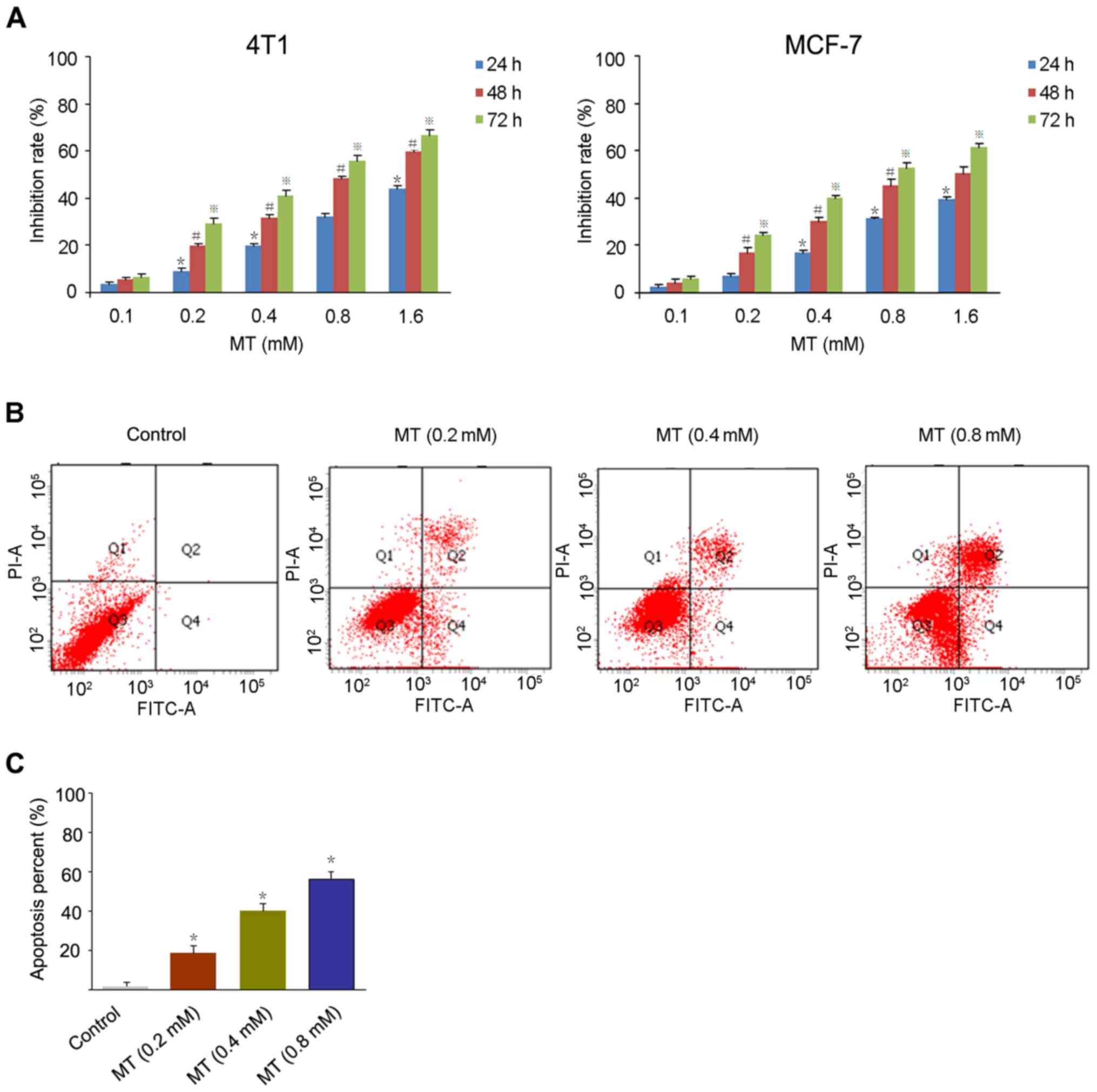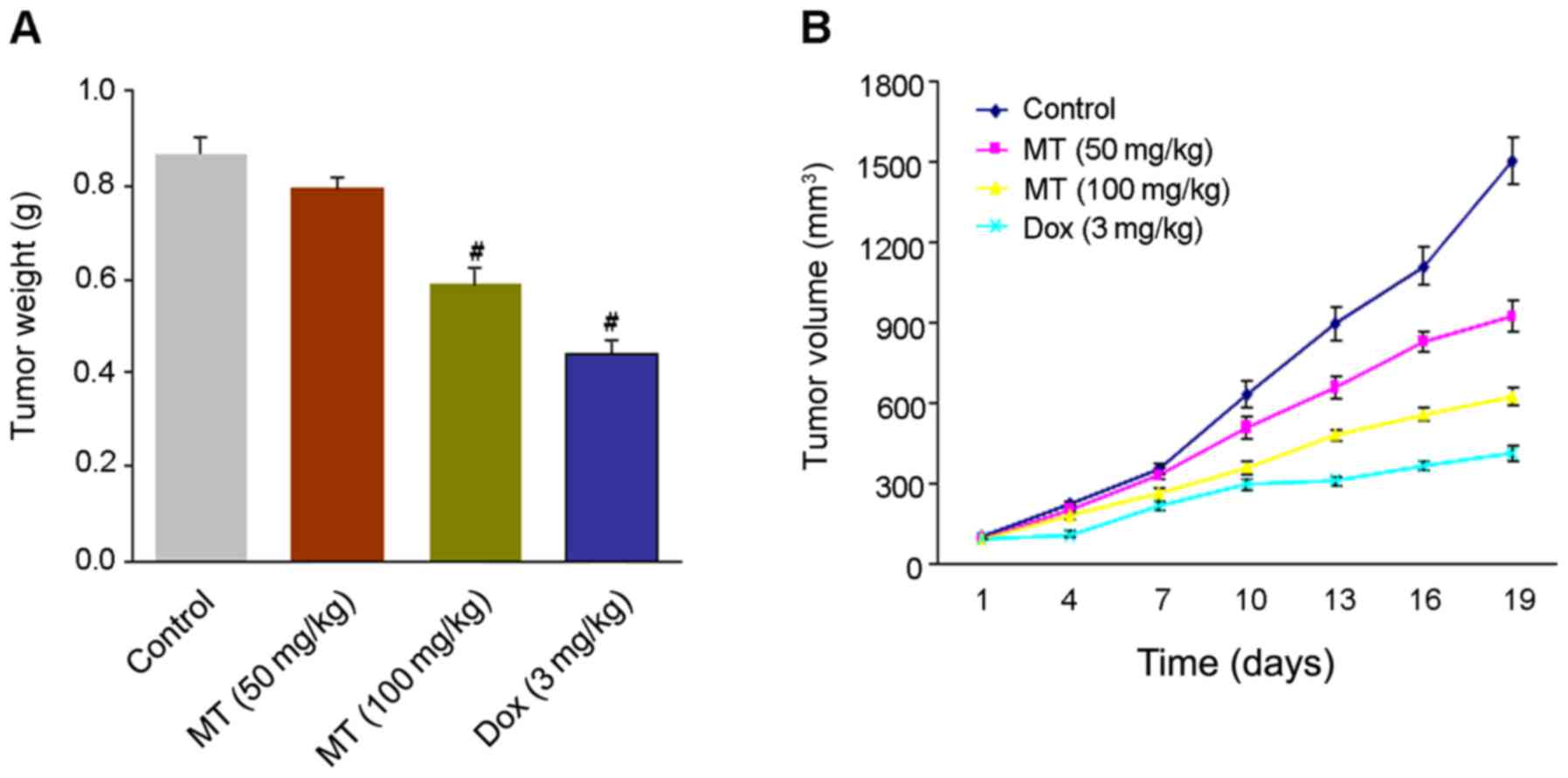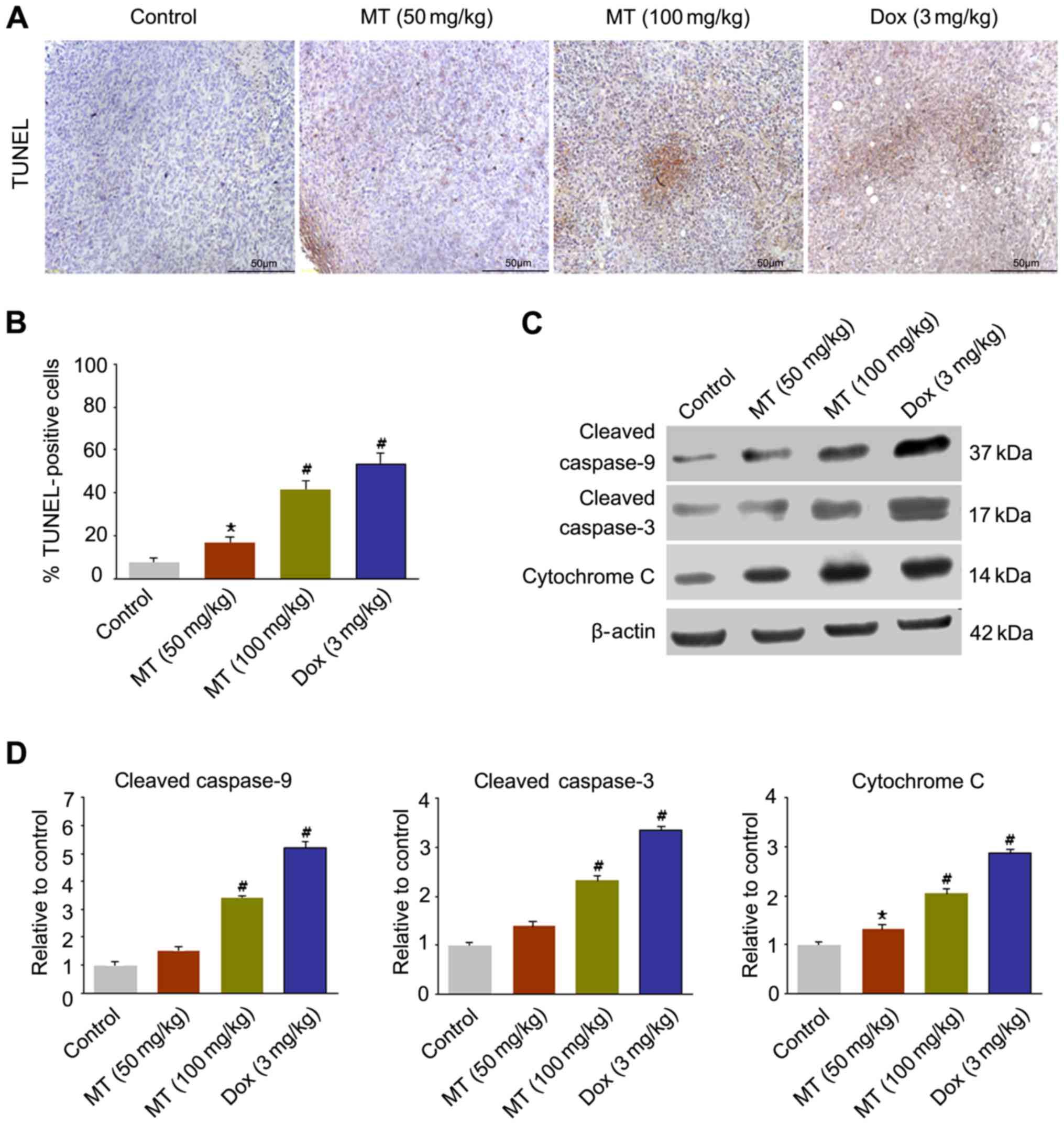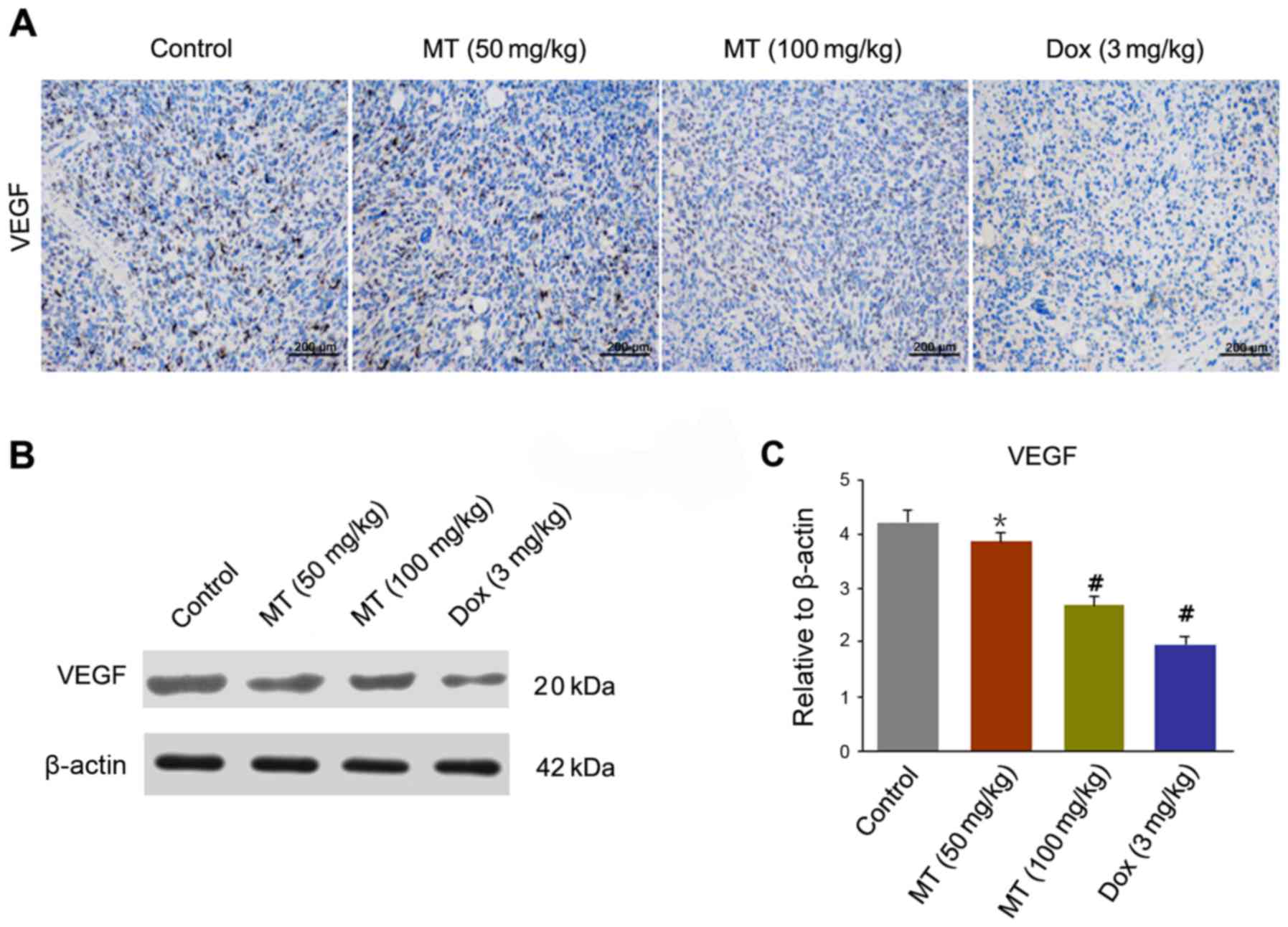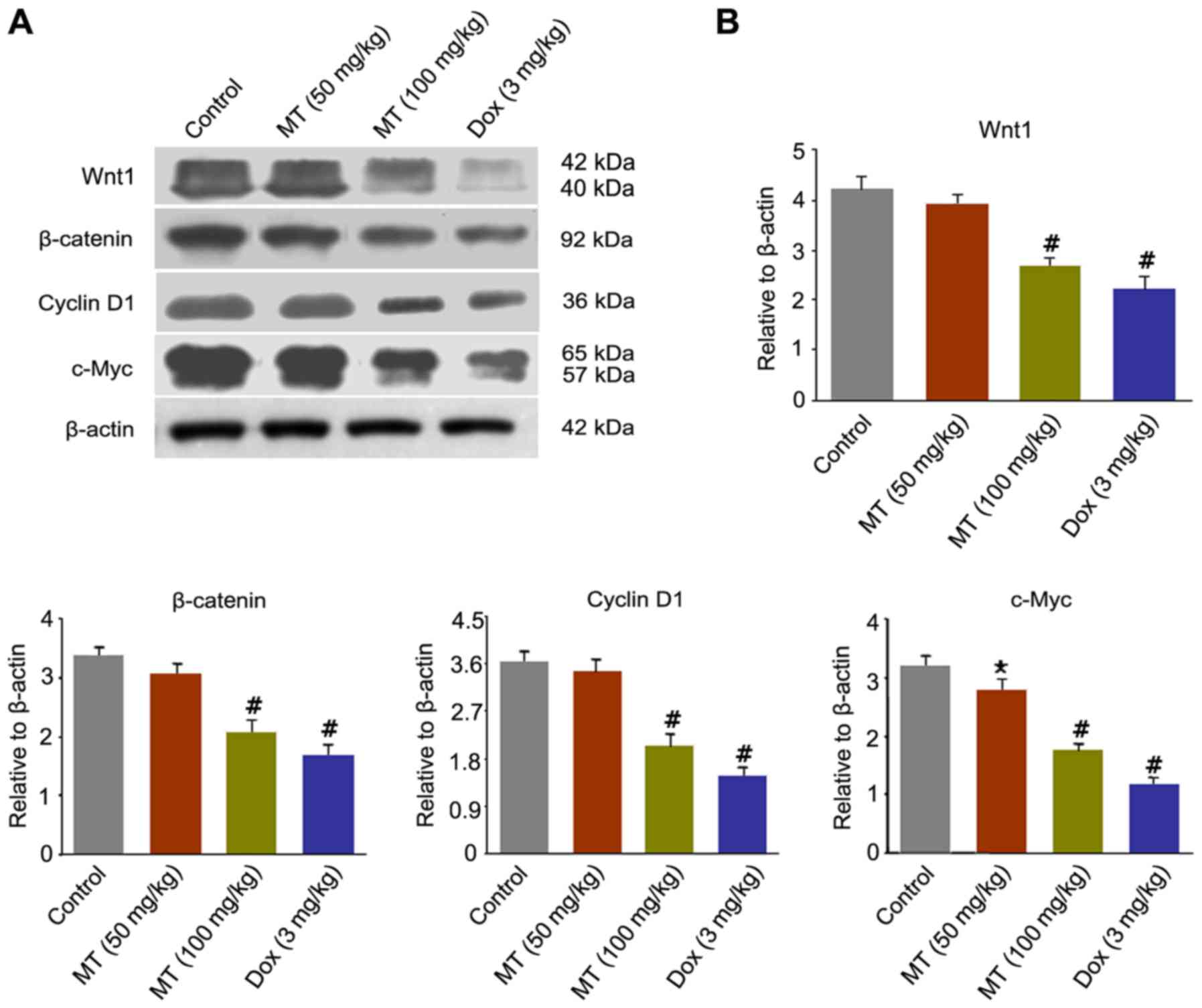Effect of matrine against breast cancer by downregulating the vascular endothelial growth factor via the Wnt/β‑catenin pathway
- Authors:
- Published online on: December 5, 2017 https://doi.org/10.3892/ol.2017.7519
- Pages: 1691-1697
-
Copyright: © Xiao et al. This is an open access article distributed under the terms of Creative Commons Attribution License.
Abstract
Introduction
As the most common type of malignancy in females worldwide, breast cancer has become the second leading cause of cancer-associated mortalities (1). Patients with breast cancer receive chemotherapy, including anthracyclines and taxanes, which cause severe cumulative toxicities and tolerability disturbance (2). Therefore, investigating alternative therapeutic drugs for the treatment of breast cancer is required in the coming years (3).
Accumulating evidence has demonstrated that certain natural products provide a novel avenue for neoplastic therapy, due to their extensive involvement in biological activities and comparatively low toxicities (4). As an effective component extracted from Chinese herbs, Sophora flavescens, matrine [MT; dodecahydro-3a, 7a-diaza-benzo (de)anthracen-8-one, molecular formula: C15H24N2O], has revealed antitumor effects by inhibiting proliferation via inducing apoptosis or altering cell cycle arrest in numerous types of cancer cells (5,6). MT was also observed to suppress proliferation, invasion and metastasis of breast cancer in vitro and in vivo (7,8). However, the underlying mechanisms of MT against breast cancer have not been fully elucidated.
The Wnt/β-catenin signaling pathway serves a vital role in the occurrence and development of various cancer types (9,10). It has been reported that Wnt1 is overexpressed in human breast cancer and upregulated in leptin-induced tumor progression (11–13). Radiation therapy may suppress self-renewal capacities of cancer stem cells by inhibiting the cyclinD1/protein kinase B1/Wnt1 signaling pathway (11–13).
Dysregulated activation of the Wnt/β-catenin signaling pathway has been surveyed in human breast cancer (14). In order to investigate the mechanisms underlying antitumor effects of MT against breast cancer, the present study hypothesized that MT may suppress breast cancer growth by downregulating the expression of vascular endothelial growth factor (VEGF) via the Wnt/β-catenin signaling pathway.
Materials and methods
Reagents, cell lines and animals
MT (purity, 99.12%) and doxorubicin (Dox) were purchased from Ningxia Bauhinia Pharmaceutical Co., Ltd. (Ningxia, China) and Pfizer, Inc. (New York, NY, USA), respectively.
The mouse 4T1 and human MCF-7 breast cancer cell lines were purchased from the American Type Culture Collection (ATCC; Manassas, VA, USA). Cancer cells were cultured in RMPI-1640 supplemented with 10% fetal bovine serum at 37°C in a humidified 5% CO2 incubator. A total of 32 female BALB/c mice (8-weeks-old; weight, 18–22 g) were obtained from the Laboratory Animal Center, Shandong University (Shandong, China). The animals were housed in a specified chamber with controlled air conditions (temperature, 20–25°C, humidity, 50–65%) with free access to sterile food and water.
MTT assay
The viability of 4T1 and MCF-7 cells was analyzed by MTT assay. Cells (5×103/well) were cultured in 96-well plates, and incubated for 24, 48 and 72 h with various concentrations of MT (0.1, 0.2, 0.4, 0.8 and 1.6 mM), which were prepared as previously described (2). The cells were incubated for an additional 4 h following the addition of MTT (20.0 ml/well). Then, the supernatants were discarded and the crystals were dissolved in 150 µl dimethyl sulfoxide. The absorbance was measured at 490 nm using a microculture plate reader (Thermo Fisher Scientific, Inc., Waltham, MA, USA). The viability (%) was calculated as the formula: (mean absorbance in control wells - mean absorbance in test wells)/mean absorbance in control wells × 100%.
Flow cytometric assay of apoptosis
4T1 cells were treated with MT (0.2, 0.4, 0.8 mM) for 48 h, harvested and the numbers of cells counted. Apoptosis was evaluated by Annexin V-fluorescein isothiocyanate/propidium iodide (PI), according to manufacturer's instructions (BD Pharmingen; BD Biosciences, Franklin Lakes, NJ, USA) and analyzed using a FACScan flow cytometer (BD FACSDiva software version 8.0.1; BD Biosciences).
Animal experiments
The protocol for in vivo experiments was approved by the Institutional Care and Use Committee of Shandong University (permit no. 201402079) and performed according to the Guide for the Care and Use of Laboratory Animals published by the US National Institutes of Health (15). Tumors were established by injection of a 4T1 cell suspension (100 µl, 5×106 cells/ml) into the right side of the 4th mammary gland of mice. The tumor length (a) and width (b) were evaluated every two days and the tumor volume was calculated as the formula: V (mm3) = (a × b2)/2 (15). When the size of tumors was ~100 mm3, mice were randomly assigned to four groups and received treatment every two days seven times (8): i) Control group (n=8), mice received intraperitoneal (i.p.) injection of saline; ii) MT group (50 mg/kg, n=8), mice received i.p. injection of MT at a dose of 50 mg/kg; iii) MT group (100 mg/kg, n=8), mice received i.p. injection of MT at a dose of 100 mg/kg; and iv) Dox group (n=8), mice received i.p. injection of Dox at a dose of 3 mg/kg. The mice were sacrificed on day 21 and the tumors were removed rapidly and weighed. Numerous tissues were fixed with 10% formaldehyde for TdT-mediated dUTP nick-end labeling (TUNEL) and immunohistochemistry (IHC), whereas others were rapidly stored at −80°C for western blotting.
TUNEL assay
Tumor sections were stained with TUNEL system (Promega Corporation, Madison, WI, USA), according to the manufacturer's instructions. Briefly, the tumor tissues from the four mouse groups were fixed in 10% formaldehyde at room temperature overnight, and then were embedded in paraffin. The sections were then deparaffinized with xylene, rehydrated and then treated with 3% hydrogen peroxide to quench the endogenous peroxidase activity. Subsequent antigen retrieval was performed by heating in citrate buffer solution (0.01 M) using a microwave oven. Sections were cut at 5 µm, dewaxed and rehydrated, washed with PBS, reacted with proteinase K (2 µl 50X proteinase K and 98 µl PBS) at room temperature for 20 min. Samples were labeled using TdT reaction mix and incubated for 1 h at 37°C in a humidified chamber (80–90%). Subsequently, 2X saline sodium citrate buffer (Ningxia Bauhinia Pharmaceutical Co., Ltd.) was added for 15 min to stop the reaction. Following hematoxylin staining, samples were mounted on to neutral balsam medium. Apoptotic cells were identified using dark brown nuclear staining (100 cells obtained from six random microscopic fields in each group) using a Nikon Eclipse 90i microscope (Nikon Corporation, Tokyo, Japan).
IHC assay
Tumor tissues from the four mouse groups were fixed in 10% formaldehyde at room temperature overnight, and then were embedded in paraffin. The sections were deparaffinized with xylene, rehydrated and then treated with 3% hydrogen peroxide at room temperature for 20 min to quench the endogenous peroxidase activity. Subsequent antigen retrieval was performed by heating in citrate buffer solution (0.01 M) using a microwave oven. Sections were 5 µm thick and stained with a VEGF antibody (1:800, cat. no. 9698; Cell Signaling Technology, Inc., Danvers, MA, USA) at 4°C overnight according to the manufacturer's instructions. Subsequently, sections were further incubated with 3,3′-diaminobenzidine tetrahydrochloride for 5 min at room temperature. The sections were observed and captured with a Nikon Eclipse 90i microscope (magnification, ×200; Nikon Corporation).
Western blotting
Western blotting was performed as previously described (15). Tumor tissues were homogenized and the supernatants were harvested by centrifugation (3,600 × g) at 4°C for 5 min. Proteins were extracted using cytoplasmic extraction reagents (Beyotime Institute of Biotechnology, Haimen, China). Protein concentration in the supernatants was determined by bicinchoninic acid assay. A total of 20 µg protein was separated using SDS PAGE (10% gel) and transferred onto polyvinylidene fluoride membranes. The membranes were blocked in 5% skimmed milk in TBST at room temperature for 1.5 h with gentle agitation and then incubated with primary antibodies at 4°C overnight, and secondary antibodies at 4°C for 1.5 h and visualized. Triplicate experiments with triplicate samples were performed. The primary antibodies were all obtained from Santa Cruz Biotechnology, Inc. (Dallas, TX, USA), including cleaved caspase-9 (cat. no. sc-24528, 1:1,000), cleaved caspase-3 (cat. no. sc-113427, 1:1,000), cytochrome c (cat. no. sc-13561, 1:800), VEGF (cat. no. sc-81670, 1:1,000), Wnt1 (cat. no. sc-6266, 1:1,000), β-catenin (cat. no. sc-221398, 1:800), cyclin D1 (cat. no. sc-70899, 1:800), c-Myc (cat. no. sc-4084, 1:800) and β-actin (cat. no. sc-70319, 1:1,000). The secondary antibodies horseradish peroxidase labeled goat anti-mouse IgG (H+L) (cat. no. A0216, 1:1,000) were obtained from Beyotime Institute of Biotechnology. The bound antibodies were visualized using an enhanced chemiluminescence reagent (EMD Millipore, Billerica, MA, USA) and quantified by densitometry using ChemiDoc™ XRS+ image system (Bio-Rad Laboratories, Inc., Hercules, CA, USA). The expression levels of proteins were quantified using model GS 800™ Calibrated Imaging Densitometry (cat. no. 170-7980; Bio-Rad Laboratories, Inc.). The signal strength of each target protein signal was normalized against the corresponding β-actin control.
Statistical analysis
One-way analysis of variance with Bonferroni adjustments for post hoc tests was used and the statistical analyses were performed with SPSS Windows version 32 statistical software (IBM Corp., Armonk, NY, USA). P<0.05 and P<0.01 were considered to indicate a statistically significant and highly significant differences, respectively.
Results
MT inhibits the growth of breast cancer cells in vitro
For the MTT assay, 4T1 and MCF-7 breast cancer cells were treated with MT at a series of concentration (0.1, 0.2, 0.4, 0.8 and 1.6 mM) for 24, 48 and 72 h, respectively. As presented in Fig. 1A, MT inhibited the growth of 4T1 and MCF-7 cells in a dose- and time-dependent manner with a half-maximal inhibitory concentration (48 h) of 0.78, and 0.86 mM, respectively.
In order to detect the apoptosis rate in cancer cells induced by MT, the Annexin V/PI method was used to stain the 4T1 cells treated with 0.2, 0.4 and 0.8 mM MT for 48 h. Fig. 1B and C demonstrates a significant increase in apoptotic cells following exposure to MT compared with the control. The apoptosis rates of 4T1 cells were 20.1% (0.2 mM), 30.2% (0.4 mM) and 57.6% (0.8 mM), respectively.
MT suppresses the growth of 4T1 tumors in vivo
As presented in Fig. 2A, a gradual loss of tumor weight was detected in the four groups. The weights of mice tumors treated with 100 mg/kg MT and 3 mg/kg Dox significantly decreased to 0.58, and 0.43 g compared with the controls (0.86 g). The average tumor volumes were determined as 923.33 and 622.34 mm3 in 50 or 100 mg/kg MT compared with 1,502.00 mm3 in the control. Notably, tumor volumes represented a reduction to 412.36 mm3 with 3 mg/kg Dox treatment. The results revealed a greater inhibitory effect on tumor growth in MT (100 mg/kg) compared with the controls (Fig. 2B).
MT induces apoptosis in 4T1 tumors in vivo
As presented in Fig. 3A and B, the apoptotic cell proportion in TUNEL-stained samples in four groups was determined. The 50 mg/kg MT treatment resulted in apoptosis in 18.95% of the tumor cells, whereas 100 mg/kg MT and 3 mg/kg Dox treatments induced apoptosis in 41.62, and 52.03% of cells (n=6), respectively.
In order to confirm the apoptosis changes, the expression levels of apoptosis-associated factors were estimated in tumors. The western blotting results demonstrated that the expression levels of cleaved caspase-9, cleaved caspase-3 and cytochrome c increased significantly in 100 mg/kg MT compared with the controls (Fig. 3C and D).
MT reduces angiogenesis in 4T1 tumor cells in vivo
To observe microvascular expression of tumor cells, the expression of VEGF in endothelial cells was determined by IHC in harvested tumor tissues (Fig. 4A). A significantly decreased level of VEGF staining was observed in tumors treated with MT and Dox compared with the control. The expression level of VEGF was significantly decreased in MT (50 mg/kg), MT (100 mg/kg) and Dox (3 mg/kg) treated cells, compared with the controls (Fig. 4B and C).
MT inhibits breast cancer growth by downregulating Wnt/β-catenin signaling pathway in vivo
To clarify the underlying mechanisms responsible for the antitumor effect of MT on breast cancer, the present study analyzed alterations in numerous important proteins of the Wnt/β-catenin signaling pathway, including Wnt1, β-catenin, cyclin D1 and c-Myc. Fig. 5A revealed that the expression levels of Wnt1, β-catenin, cyclin D1 and c-Myc were markedly decreased in the treatment of MT and Dox compared with the control. Following MT (100 mg/kg) exposure, the expression levels of Wnt1, β-catenin, cyclin D1 and c-Myc significantly decreased by 33.3, 36.36, 44.44 and 43.75%, respectively, compared with the control (Fig. 5B).
Discussion
Breast cancer is the most frequent type of malignancy in females worldwide and affects 1.3 million individuals (1). The prognosis of breast cancer remains poor despite recent advances in the therapeutic regimens. Therefore, studies aiming to identify a successful therapeutic strategy should be a priority. MT was revealed to possess antitumor function of inhibiting cell growth and proliferation in various cancer cell lines, including hepatoma, acute myeloid leukemia, gastric carcinoma, lung cancer and breast cancer (4,16–19). Numerous studies focused on the antitumor activity of MT against breast cancer in vitro; however, the mechanisms have not been fully elucidated (2,7). Thus, the present study investigated the anti-breast-cancer effects of MT in vitro and in vivo.
Uncontrolled proliferation serves an important role in tumorigenesis, and the suppression of cancer cell proliferation is a key aspect in tumor therapy (20). For the in vitro experiments, the present study performed an MTT assay to evaluate cell viability by treating cells with a series concentrations of MT (0.1–1.6 mM). The results indicated that MT had a dose- and time-dependent inhibition effect on growth of 4T1, and MCF-7 cells. Furthermore, the 4T1 cells were more sensitive to MT compared with MCF-7 cells. The pro-apoptotic effect of MT on 4T1 cells was confirmed by flow cytometry. The results of the present study were in accordance with previous studies, which demonstrated that MT significantly inhibited the growth of breast cancer (11–13). For the in vivo experiments, the 4T1-tumor bearing mice were treated with MT (100 mg/kg) or Dox and demonstrated a significant reduction in tumor weight and volume compared with the control. However, the reduction in tumor weight and volume was insignificant in the MT 50 mg/kg group. The TUNEL results and expression levels of apoptotic-associated factors demonstrated the pro-apoptosis activity of MT, and Dox against breast neoplasms.
Tumor growth is not only due to abnormal proliferation, but also depends on a reduction in apoptosis (21). Hence, the induction of apoptosis is a major underlying mechanism in chemotherapy. Cellular apoptosis involves the extrinsic pathway induced by the death-receptor and the intrinsic pathway, also known as mitochondrial pathway. In the intrinsic pathway, the release of cytochrome c activates caspase-9, which subsequently induces the activation of caspase-3. Activated caspase-3 serves a role in the apoptotic pathway for the cleavage of various cellular targets (22,23). The results of the present study demonstrated that the expression levels of cleaved caspase-9, cleaved caspase-3 and cytochrome c decreased significantly in 100 mg/kg MT-treated mice compared with the control, which implied that the mitochondrial pathway may be involved in MT-induced apoptosis in 4T1-tumors.
Angiogenesis serves an important role in the development of tumor growth (24). As a crucial antigenic cytokine, VEGF is the major regulator of endothelial cell survival (25). The decrease of VEGF is considered to be a key prognostic indicator in patients with breast cancer (26). In the present study, the expression levels of VEGF were observed by IHC and western blotting at a higher level in the controls, and were downregulated significantly in MT-treated mice at a dose of 100 mg/kg. VEGF is a major downstream target of the Wnt/β-catenin signaling pathway. The sustained activation of the Wnt/β-catenin signaling pathway was observed in the development of numerous types of cancer, including breast cancer. At normal levels, β-catenin is degraded via the ubiquity pathway. When the oncogenes activated Wnt, the β-catenin translocated to the nucleus in the formation of polymers, resulting in regulating target gene expression levels, including cyclin D1 and c-Myc (12–14).
It was demonstrated that the expression level of Wnt1 mRNA was markedly upregulated in human breast cancer cells (27). Furthermore, Wnt1 was able to inhibit the processes of apoptosis by obstructing the release of cytochrome c and restricting the activation of caspase-9 (28). Cyclin D1 increased the cell proliferation in various type of cancer by promoting the transition from G0/G1 to the S cell cycle phase (29). c-Myc has been revealed to by overexpressed in breast cancer, which is associated with poor curative effect. Repressing c-Myc expression is a critical event in the tumor suppressor, which is likely to be highly relevant in the novel therapy designation (30,31). MT was able to inhibit human pancreatic cancer cell migration via downregulating the Wnt signaling pathway. Therefore, it is of interest to investigate whether apoptosis is induced by MT via the Wnt/β-catenin signaling pathway. In the present study, the high expression levels of Wnt1, β-catenin, cyclin D1 and c-Myc implied that the Wnt/β-catenin signaling pathway serves an important role in breast cancer development, which is consistent with previous studies. MT treatment (100 mg/kg) caused a marked reduction in the expression levels of major proteins compared with the control, which suggested that MT effectively inhibits breast cancer growth by downregulating the Wnt/β-catenin signaling pathway and may be a potential drug in cancer therapy.
Acknowledgements
The present study was supported by Chengde City Science and Technology Research and Development Program (grant no. 201701A068).
References
|
Jemal A, Bray F, Center MM, Ferlay J, Ward E and Forman D: Global cancer statistics. CA Cancer J Clin. 61:69–90. 2011. View Article : Google Scholar : PubMed/NCBI | |
|
Li LQ, Li XL, Wang L, Du WJ, Guo R, Liang HH, Liu X, Liang DS, Lu YJ, Shan HL and Jiang HC: Matrine inhibits breast cancer growth via miR-21/PTEN/Akt pathway in MCF-7 cells. Cell Physiol Biochem. 30:631–641. 2012. View Article : Google Scholar : PubMed/NCBI | |
|
Vahdat LT, Pruitt B, Fabian CJ, Rivera RR, Smith DA, Tan-Chiu E, Wright J, Tan AR, Dacosta NA, Chuang E, et al: Phase II study of eribulin mesylate, a halichondrin B analog, in patients with metastatic breast cancer previously treated with an anthracycline and a taxane. J Clin Oncol. 27:2954–2961. 2009. View Article : Google Scholar : PubMed/NCBI | |
|
Zhang S, Zhang Y, Zhuang Y, Wang J, Ye J, Zhang S, Wu J, Yu K and Han Y: Matrine induces apoptosis in human acute myeloid leukemia cells via the mitochondrial pathway and Akt inactivation. PLoS One. 7:e468532012. View Article : Google Scholar : PubMed/NCBI | |
|
Li T, Wong VK, Yi XQ, Wong YF, Zhou H and Liu L: Matrine induces cellanergy in human Jurkat T cells through modulation of mitogen-activated protein kinases and nuclear factor of activated T-cells signaling with concomitant upregulation of anergy-associated genes expression. Biol Pharm Bull. 33:40–46. 2010. View Article : Google Scholar : PubMed/NCBI | |
|
Zhang S, Cheng B, Li H, Xu W, Zhai B, Pan S, Wang L, Liu M and Sun X: Matrine inhibits proliferation and induces apoptosis of human colon cancer LoVo cells by inactivating Akt pathway. Mol Biol Rep. 41:2101–2108. 2014. View Article : Google Scholar : PubMed/NCBI | |
|
Yu P, Liu Q, Liu K, Yagasaki K, Wu E and Zhang G: Matrine suppresses breast cancer cell proliferation and invasion via VEGF-Akt-NF-kappaB signaling. Cytotechnology. 59:219–229. 2009. View Article : Google Scholar : PubMed/NCBI | |
|
Li H, Tan G, Jiang X, Qiao H, Pan S, Jiang H, Kanwar JR and Sun X: Therapeutic effects of Matrine on primary and metastatic breast cancer. Am J Chin Med. 38:1115–1130. 2010. View Article : Google Scholar : PubMed/NCBI | |
|
Polakis P: The many ways of Wnt in cancer. Curr Opin Genet Dev. 17:45–51. 2007. View Article : Google Scholar : PubMed/NCBI | |
|
Smalley MJ and Dale TC: Wnt signalling in mammalian development and cancer. Cancer Metastasis Rev. 18:215–230. 1999. View Article : Google Scholar : PubMed/NCBI | |
|
Katoh M: Expression and regulation of WNT1 in human cancer: Up-regulation of WNTI by beta-estradiol in MCF-7 cells. Int J Oncol. 22:209–212. 2003.PubMed/NCBI | |
|
Sun H, Ding C, Zhang H and Gao J: Let-7 miRNAs sensitize breast cancer stem cells to radiation-induced repression through inhibition of the cyclin D1/Akt1/Wnt1 signaling pathway. Mol Med Rep. 14:3285–3292. 2016. View Article : Google Scholar : PubMed/NCBI | |
|
Si W, Li Y, Shao H, Hu R, Wang W, Zhang K and Yang Q: miR-34a inhibits breast cancer proliferation and progression by targeting Wnt1 in Wnt/β-catenin signaling pathway. Am J Med Sci. 352:191–199. 2016. View Article : Google Scholar : PubMed/NCBI | |
|
Wang Z, Li B, Zhou L, Yu S, Su Z, Song J, Sun Q, Sha O, Wang X, Jiang W, et al: Prodigiosin inhibits Wnt/β-catenin signaling and exerts anticancer activity in breast cancer cells. Proc Natl Acad Sci USA. 113:pp. 13150–13155. 2016; View Article : Google Scholar : PubMed/NCBI | |
|
Wu J, Xue X, Zhang B, Jiang W, Cao H, Wang R, Sun D and Guo R: The protective effects of paeonol against epirubicin-induced hepatotoxicity in 4T1-tumor bearing mice via inhibition of the PI3K/Akt/NF-kB pathway. Chem Biol Interact. 244:1–8. 2016. View Article : Google Scholar : PubMed/NCBI | |
|
Zhang X and Yu H: Matrine inhibits diethylnitrosamine-induced HCC proliferation in rats through inducing apoptosis via p53, Bax-dependent caspase-3 activation pathway and down-regulating MLCK overexpression. Iran J Pharm Res. 15:491–499. 2016.PubMed/NCBI | |
|
Zhang JW, Su K, Shi WT, Wang Y, Hu PC, Wang Y, Wei L, Xiang J and Yang F: Matrine inhibits the adhesion and migration of BCG823 gastric cancer cells by affecting the structure and function of the vasodilator-stimulated phosphoprotein (VASP). Acta Pharmacol Sin. 34:1084–1092. 2013. View Article : Google Scholar : PubMed/NCBI | |
|
An Q, Han C, Zhou Y, Li F, Li D, Zhang X, Yu Z, Duan Z and Kan Q: Matrine induces cell cycle arrest and apoptosis with recovery of the expression of miR-126 in the A549 non-small cell lung cancer cell line. Mol Med Rep. 14:4042–4048. 2016. View Article : Google Scholar : PubMed/NCBI | |
|
Li H, Li X, Bai M, Suo Y, Zhang G and Cao X: Matrine inhibited proliferation and increased apoptosis in human breast cancer MCF-7 cells via upregulation of Bax and downregulation of Bcl-2. Int J Clin Exp Pathol. 8:14793–14799. 2015.PubMed/NCBI | |
|
Jiang H, Hou C, Zhang S, Xie H, Zhou W, Jin Q, Cheng X, Qian R and Zhang X: Matrine upregulates the cell cycle protein E2F-1 and triggers apoptosis via the mitochondrial pathway in K562 cells. Eur J Pharmacol. 559:98–108. 2007. View Article : Google Scholar : PubMed/NCBI | |
|
Song M, Wu H, Wu S, Ge T, Wang G, Zhou Y, Sheng S and Jiang J: Antibiotic drug levofloxacin inhibits proliferation and induces apoptosis of lung cancer cells through inducing mitochondrial dysfunction and oxidative damage. Biomed Pharmacother. 84:1137–1143. 2016. View Article : Google Scholar : PubMed/NCBI | |
|
Shao H, Yang B, Hu R and Wang Y: Matrine effectively inhibits the proliferation of breast cancer cells through a mechanismrelated to the NF-κB signaling pathway. Oncol Lett. 6:517–520. 2013. View Article : Google Scholar : PubMed/NCBI | |
|
Liu M, Xiusheng H, Xiao X and Wang Y: Overexpression of miR-422a inhibits cell proliferation and invasion and enhances chemosensitivity in osteosarcoma cells. Oncol Rep. 36:3371–3378. 2016. View Article : Google Scholar : PubMed/NCBI | |
|
Kim D, Ku SH, Kim H, Jeong JH, Lee M, Kwon IC, Choi D and Kim SH: Simultaneous regulation of apoptotic gene silencing and angiogenic gene expression for myocardial infarction therapy: Single-carrier delivery of SHP-1 siRNA and VEGF-expressing pDNA. J Control Release. 243:182–194. 2016. View Article : Google Scholar : PubMed/NCBI | |
|
Luo J, Zhong Y, Huang S, Li L, Zhang C and Zou X: Ginkgolide B enhances the differentiation of preosteoblastic MC3T3-E1 cells through VEGF: Involvement of the p38 MAPK signaling pathway. Mol Med Rep. 14:4787–4794. 2016. View Article : Google Scholar : PubMed/NCBI | |
|
Ławicki S, Zajkowska M, Głażewska EK, Będkowska GE and Szmitkowski M: Plasma levels and diagnostic utility of VEGF, MMP-2 and TIMP-2 in the diagnostics of breast cancer patients. Biomarkers. 24:157–164. 2017. View Article : Google Scholar | |
|
Avtanski DB, Nagalingam A, Kuppusamy P, Bonner MY, Arbiser JL, Saxena NK and Sharma D: Honokiol abrogates leptin-induced tumor progression by inhibiting Wnt1-MTA1-β-catenin signaling axis in a microRNA-34a dependent manner. Oncotarget. 6:16396–16410. 2015. View Article : Google Scholar : PubMed/NCBI | |
|
Ma X, Yan W, Dai Z, Gao X, Ma Y, Xu Q, Jiang J and Zhang S: Baicalein suppresses metastasis of breast cancer cells by inhibiting EMT via downregulation of SATB1 and Wnt/β-catenin pathway. Drug Des Devel Ther. 10:1419–1441. 2016. View Article : Google Scholar : PubMed/NCBI | |
|
Chu Q, Han N, Yuan X, Nie X, Wu H, Chen Y, Guo M, Yu S and Wu K: DACH1 inhibits cyclin D1 expression, cellular proliferation and tumor growth of renal cancer cells. J Hematol Oncol. 7:732014. View Article : Google Scholar : PubMed/NCBI | |
|
Janghorban M, Farrell AS, Allen-Petersen BL, Pelz C, Daniel CJ, Oddo J, Langer EM, Christensen DJ and Sears RC: Targeting c-MYC by antagonizing PP2A inhibitors in breast cancer. Proc Natl Acad Sci USA. 111:pp. 9157–9162. 2014; View Article : Google Scholar : PubMed/NCBI | |
|
Kim JY, Valencia T, Abu-Baker S, Linares J, Lee SJ, Yajima T, Chen J, Eroshkin A, Castilla EA, Brill LM, et al: c-Myc phosphorylation by PKCζ represses prostate tumorigenesis. Proc Natl Acad Sci USA. 110:pp. 6418–6423. 2013; View Article : Google Scholar : PubMed/NCBI |



